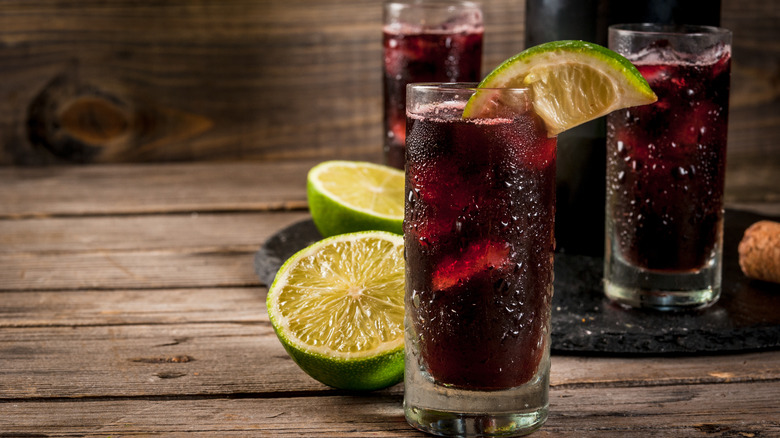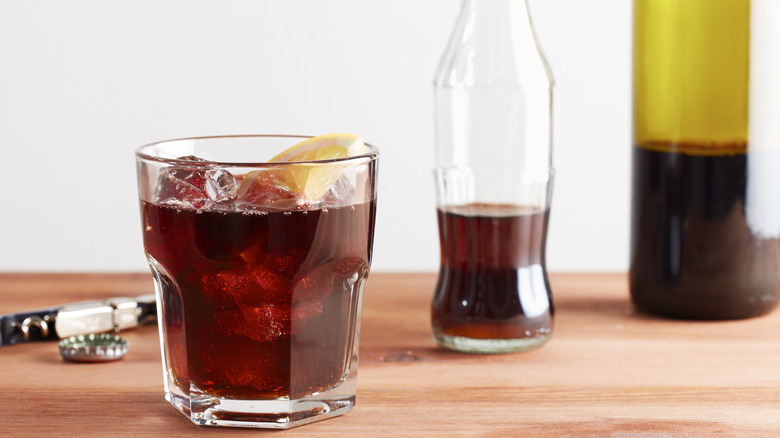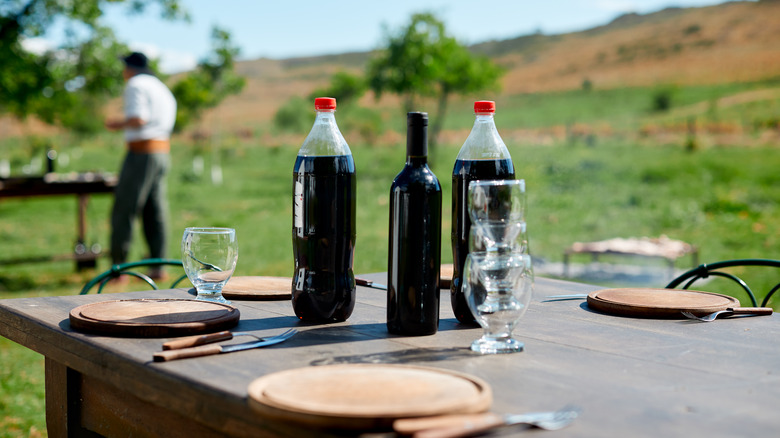Spain's Kalimotxo Cocktail Uses Coke To Make The Most Of Cheap Red Wine
The Spanish concoction Kalimotxo or Calimocho (pronounced: kaa-lee-mo-cho), made of equal parts red wine and Coke, has many names around the world — katemba in South Africa, bambus in Croatia, and Jesus juice in Argentina. That last name may be because it goes down so easily that you'll be taking his name in vain the following day after drinking too much of it. Call it what you will, this drink takes pride in its simplicity, and though first-timers may find the taste reminiscent of cherry-flavored cough syrup (Txerry Kalimotxo, if you like), fans stand by this wine cocktail as an easy and refreshing way to consume cheap red wine.
The origin of Kalimotxo, or at least its most popular monicker, is said to be rooted in masking the somewhat unmellowed notes of an immature red. Nowadays, cheap wine is an essential ingredient of this unfussy drink, and cola's caffeine content makes it great to sip on at the start of a long night. However, it's also one of those drinks that's easy to drink a lot of, so remember to be kind to your future self. That said, Kalimotxo is a worthy member of Spain's culinary quirks, which include the world's most expensive cheese and possibly the best pizza outside Italy.
How to make your Kalimotxo right
Get a half-empty plastic bottle of Coke and top it up with an inexpensive red wine (a Spanish red like a Tempranillo works well) — that's a Kalimotxo done right. It's easy to see why this drink is popular amongst Spain's college crowd and why you might hear about it from a young person just back from a summer in Europe.
Since Coke masks the taste of the wine, any leftover wine you're not enjoying becomes a Kalimotxo candidate. The flavor mixes the cola's sweetness and the wine's tartness, so a dry red's low sweetness pairs well with Coke's sugary notes. However, just because the drink is simple doesn't mean it can't be nuanced. Without pretending to be a sommelier, checking a wine's flavor profile will give you a good idea of how well it'll pair with cola. The astringent and slightly spicy notes of a Cabernet Sauvignon or Shiraz contrast well with Coke, while the mellow Merlot will result in a simple and sweet Kalimotxo. If you're at a party or drinking at a pub, pay attention to the wine you decide to top up with Coke, as mixing an expensive red can quickly turn into a social faux pas.
And since we're bending the rules of wine drinking anyway, add a healthy dose of ice cubes. A squeeze of lemon or an orange wedge is optional, but getting too fussy with the garnishing is defeating the purpose of the drink.
Fittingly, Kalimotxo got its name at a party
Before the wine and cola mix became popular as Kalimotxo, versions of it, under monickers like Rioja Libre, Cuba Libe del Pobre, Tincola, and Cubata del Obrero, have been around since the 1920s. However, the popular version of this cocktail can be dated back to 12th August 1972 when the St. Nicholas festival was being celebrated in the Old Port of Algorta in the Getxo ("Guecho") province of Spain's Basque country. The party organizers realized that they had somehow received thousands of liters of spoilt wine and, rather than letting the crowd go thirsty, decided to salvage it by masking its taste.
The other tested combinations remain unknown, but mixing equal parts Coke and funky wine resulted in a most palatable drink. Of course, by mixing in equal parts cola, the quantity of beverage they had in stock (and, therefore, had to sell) doubled, and an attractive name was needed to help market the drink (and perhaps stop those drinking it from asking what exactly went into it).
The legend of how the name came about, much like the origin of the word "cocktail," is also quite bizarre. An acquaintance of the organizers, and a man not famous for his looks who went by the name Kalimero, inspired the first half of the term. The word "motxo," roughly translates to "ugly" in the local dialect, and it was decided to combine the two, giving generations of drinkers an intriguing concoction that doesn't mind offending wine and coke purists in equal measure.


